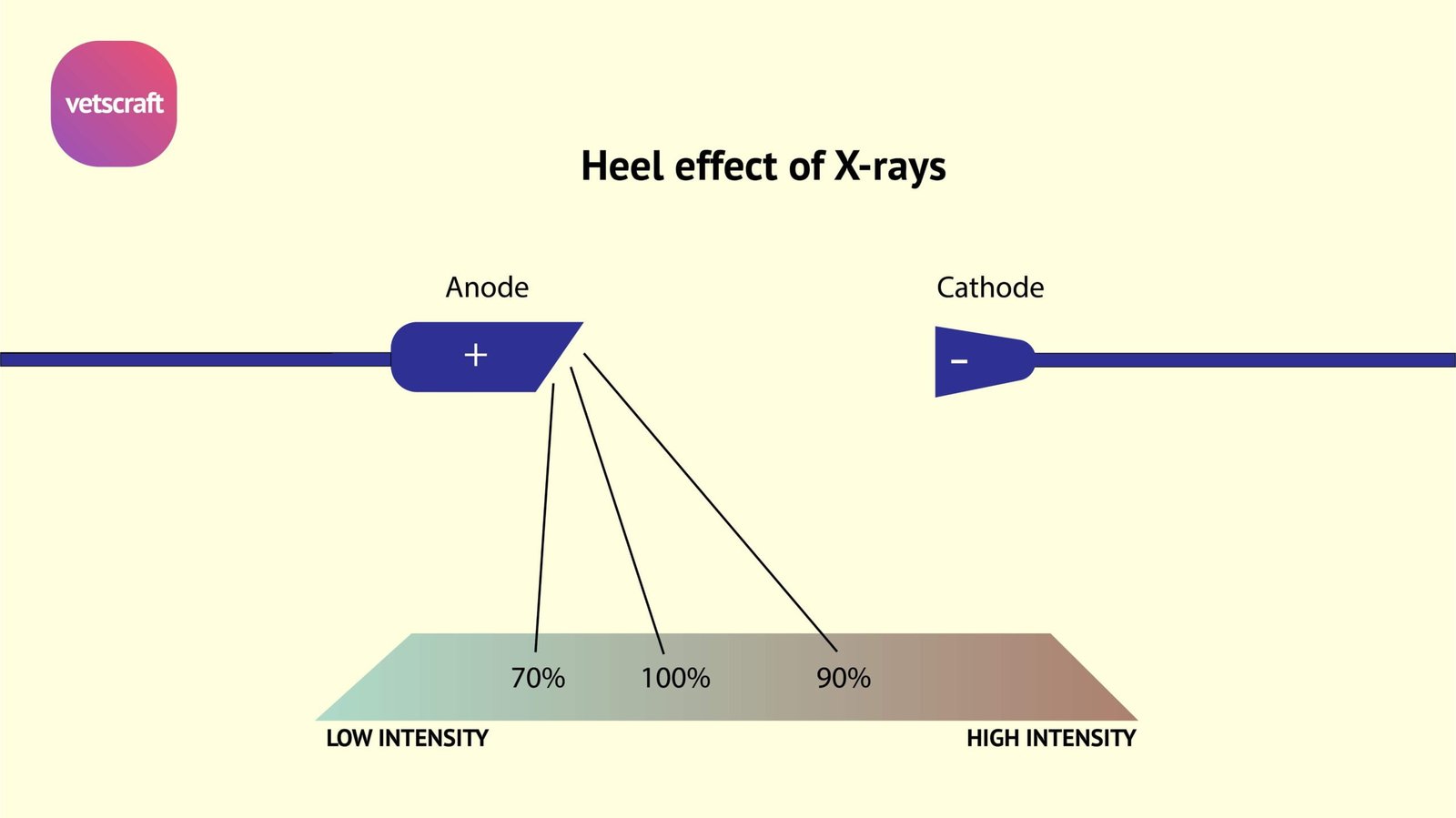TABLE OF CONTENTS
Factors influencing x-rays production
Factors influencing x-rays production are Kilo voltage & Milliampere used, Heel effect, Exposure time, Focal Spot, Focal-Film Distance, Image magnification, Image Distortion and Image Unsharpness.
Kilo Voltage (kVp)
Kilovoltage (kVp) is the force that accelerates the electrons from the cathode to the anode. kVp means the kilovoltage peak or the crest of waveform representing x-ray photon energy.
The kVp is the force behind the stream of electrons that determines the speed at which the electrons ‘slam’ or ‘bombard’ into the focal spot. It is the most significant factor in the production of x-rays and radiographs. The stream of electrons is called the Tube current or Cathode rays.
‘Kilo’ means one thousand. So, a kV setting of 80 means – 80,000 volts will be produced to push the electrons across the x-ray tube at the time of exposure. The energy of the x-ray beam is determined by the kilovoltage selection.
Increase in kVp increases the radiographic density.
Milliampere (mA)
Milliampere (mA) is defined as the current that flow through the cathode filament at the time of exposure. It is the second important technical factor.
An increase in milliampere will increase the number of x-ray photons in the x-ray beam. A doubling of the milliampere will double the amount of blackening in the film.
“Milliampere” is the important ‘factor of choice’ to control the blackening of the film.
Exposure time(S)
Exposure time (S) is the technical factor that controls the time of exposure. It is also a quantitative factor (s), when combined with milliampere (mA) it determines the exposure rate (mAs).
Milliampere x Time = Milliamperesecond
mA x s = mAs
An increase in the mAs increases the x-ray photons exposing the film.
The mA and time relationship is inversely proportional and hence an increase in mA requires a decrease in the exposure time.
Focal Spot
The focal spot on the target surface of the anode is the area which is bombarded, by the electrons from the cathode during an exposure. The rotating target produces a focal track that runs the circumference of the rotating disk. Umbra is the true object recorded on the film. Penumbra is the thin blurred area around the umbra. Penumbra is unsharpness.
Focal-Film Distance (FFD)
Focal-Film Distance (FFD) is measured from the focal spot to the recording medium (x-ray film in the cassette). In veterinary radiography, 90-100cm FFD is considered a good compromise between the distance and exposure factors.
Increase in FFD decreases the total number of x-rays available to expose the film.
Heel Effect
Heel effect refers to the lower field intensity towards the anode in comparison to the cathode. it is due to variation of the intensity of X-rays emitted by the anode.

Image magnification
Magnification of some degree is usually present in every clinical radiograph because the image formed is a two dimensional representation of a three dimensional structure. Magnification has to be kept as low as possible except in vascular radiography, to reduce the magnification, part to be examined should be as close as possible to the film called as part film Distance (PFD)Should be always ‘Zero’.
FFD/Source Image Distance – Between 90 – 100 cm will be compromise between magnification effect and increased exposure factors.
Image Distortion
A radiograph is not an exact picture of the structure being examined and differences of varying degrees are present in the shape and size and such misrepresentation of shape and size is called as Image Distortion. Distortion means unequal magnification of different portions of the same object. The Distortion of image depends on shape of the object and position of the object.
Elongation: Distortion of anatomic structure when the image appears longer than actual size owing to the x-ray beam not being directed perpendicular to the film surface.
Fore shortening: Distortion of anatomic structure when the image appears shorter than actual size due to plan of interest not being parallel to the film surface.
Spatial Distortion: It can occur when objects of same size are positioned at different distances from the film.
Image Unsharpness
Image unsharpness also a factors influencing x-rays production by loss of detail due to geometric distortion.
Penumbra / edge gradient often called as geometric unsharpness which refers to partial outer shadow of an object being imaged by illumination.
Motion Unsharpness: refers to loss of radiographic quality due to movement of either the patient or the X-ray tube or the film during X-ray exposure.
Absorption Unsharpness: this type of unsharpness arise from gradual change in X-ray absorption across the boundary or periphery or center of the object. This leads to unsharp edges.
Screen Unsharpness: Unsharpness caused by light diffusion in the screen phosphor layer. This can be avoided by maintaining a good film-screen contact and by using a fine grain screen. Use of intensifying screens with high intensification factors reduces exposure factors but cause image unsharpness.
Note
Image magnification, Distortion, and Image Unsharpness are the Geometric factors that influencing x-ray production. these can be eliminated by proper use of x-ray machine.